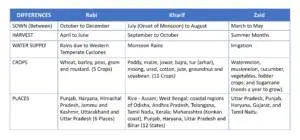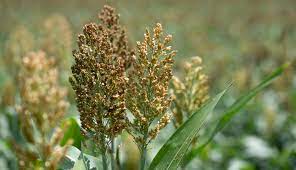No products in the cart.

Understanding Kharif and Rabi Seasons in Indian
Understanding the Kharif and Rabi Seasons in Indian Agriculture
The agricultural calendar in India is dominated by two main cropping seasons: Kharif and Rabi. These seasons play a crucial role in shaping the agricultural landscape of the country, impacting everything from crop choices to market prices. In this article, we will explore what these seasons entail, their significance, and how they contribute to India’s agricultural output.

Table of Contents
| Sr# | Headings |
|---|---|
| 1. | Introduction |
| 2. | What is the Kharif Season? |
| 3. | Key Crops of the Kharif Season |
| 4. | Climate and Planting Time |
| 5. | Challenges and Precautions |
| 6. | What is the Rabi Season? |
| 7. | Key Crops of the Rabi Season |
| 8. | Climate and Planting Time |
| 9. | Challenges and Precautions |
| 10. | Economic Impact |
| 11. | Differences between Kharif and Rabi Crops |
| 12. | Importance of Crop Rotation |
| 13. | Conclusion |
| 14. | FAQs about Kharif and Rabi Seasons |
Introduction
In India, agriculture is not just a source of livelihood; it is a way of life. The rhythm of farming is dictated by the monsoons, dividing the year into two main planting seasons: Kharif and Rabi. Understanding these seasons is crucial for farmers and consumers alike, as they directly influence the availability and pricing of essential food crops.
What is the Kharif Season?
The Kharif season, also known as the summer or monsoon crop season, starts with the onset of the southwest monsoon in June and continues until September. This season is characterized by high temperatures and adequate rainfall, which are ideal for the cultivation of certain crops.
Key Crops of the Kharif Season
During the Kharif season, farmers plant a variety of crops such as rice, maize, millets, cotton, and soybeans. These crops require a lot of water and warmth to grow, making them well-suited to the Indian climate during the monsoon.
Climate and Planting Time
The Kharif crops are sown with the arrival of the monsoon rains, which vary in timing and intensity across different regions of India. The planting window typically starts in June and extends through July.
Challenges and Precautions
Excessive rainfall can lead to flooding and waterlogging, posing a risk to crops. Farmers must also watch out for pests and diseases that thrive in the warm and wet conditions of the Kharif season.
What is the Rabi Season?
The Rabi season, or the winter crop season, begins in October immediately after the monsoon season ends. This season relies on irrigation rather than rainfall for cultivation.
Key Crops of the Rabi Season
Major Rabi crops include wheat, barley, oats, chickpeas, and mustard. These crops are sown in the winter and harvested in spring, taking advantage of the mild winter conditions.
Climate and Planting Time
Rabi crops are planted after the monsoon season, using residual soil moisture and supplemental irrigation. The planting window typically starts from October and lasts until December.
Challenges and Precautions
The main challenge during the Rabi season is ensuring an adequate water supply for the crops, as this season is relatively dry compared to Kharif. Proper irrigation management is essential to prevent water stress in crops.
Economic Impact
Both Kharif and Rabi crops play a significant role in India’s economy. The success of these seasons determines the availability of food grains and their prices in the market, directly affecting farmers’ incomes and consumer spending.
Differences between Kharif and Rabi Crops
The primary difference lies in the timing of cultivation and the type of crops grown. Kharif crops are sown in the monsoon and harvested before the onset of winter, whereas Rabi crops are sown in winter and harvested in spring.
Importance of Crop Rotation
Crop rotation, alternating between Kharif and Rabi crops, helps in maintaining soil fertility, controlling pests and diseases, and optimizing water usage. It is a sustainable farming practice that has been practiced for centuries.
Conclusion
The Kharif and Rabi seasons form the backbone of India’s agricultural sector, ensuring food security and economic stability. By understanding these seasons, we can appreciate the intricate relationship between farming, climate, and culture in India.
FAQs about Kharif and Rabi Seasons
1. What is the difference between Kharif and Rabi seasons? Kharif crops are sown in the monsoon and harvested before winter, while Rabi crops are sown in winter and harvested in spring.
2. Which crops are grown during the Kharif season? Major Kharif crops include rice, maize, millets, cotton, and soybeans.
3. What are the main challenges faced during the Kharif season? Excessive rainfall and pest infestations are common challenges during the Kharif season.
4. How does the Rabi season differ from the Kharif season in terms of irrigation? Rabi crops rely on irrigation for water, whereas Kharif crops benefit from monsoon rains.
5. Why is crop rotation important? Crop rotation helps maintain soil fertility, control pests, and optimize water usage, ensuring sustainable agriculture.
This comprehensive guide should provide you with a good understanding of the Kharif and Rabi seasons, their importance, and their impact on India’s agricultural landscape. Whether you are a farmer, consumer, or simply interested in agriculture, these insights will help you appreciate the nuances of Indian farming practices.
Go and turn on towards organic farming to save future and thire save childs:
Elevate Plant Growth with Premium Bone Powder – Buy Now!
Organic Cow Dung Compost: Transform Your Garden Naturally
Premium Humic Acid for Healthy Plants | Enhance Soil & Boost Growth
Boost Plant Growth Naturally with Mustard Cake | Organic Fertilizer
Transform Your Garden with NPK Fertilizer | Boost Growth by 30%
Premium Perlite for Enhanced Gardening | Buy Now
Live Earthworms with Enhance Your Garden (soil health)
1 Neem Khali: Unveiling the Wonders of Nature
1Transform your garden with vermiwash-buy now
1 Premium quality Vermicompost [ केचुआ खाद ]
Follow us:
Must visit:
सत्ता की साझेदारी से आप क्या समझते हैं
Vegetable Farming A Guide to Successful Cultivation
Discover Mustard Crop: Cultivation, Uses, and Health Benefits
Tagged InKharif and Rabi Seasons rabi and kharif



